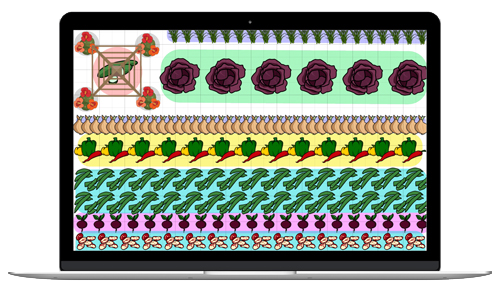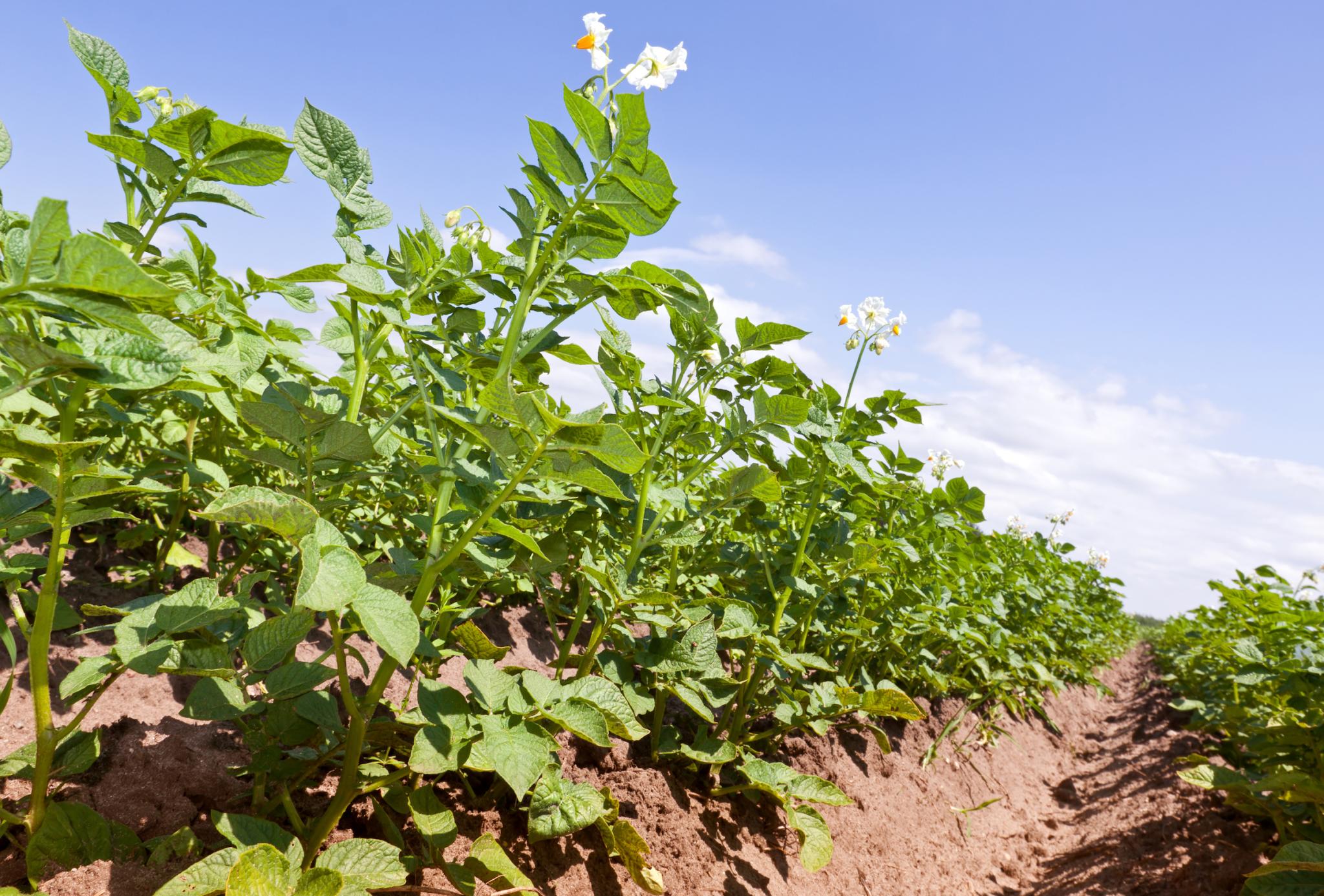
Planting, Growing, Harvesting, and Storing Potato Plants
The Almanac Garden Planner - Use It Free for 7 Days!
Plan your 2025 garden with our award-winning Garden Planner.
There are three classifications for potatoes based on when you harvest (vs. when you plant). If you harvest for storage, be sure to choose the right type:
- Early-season potatoes: first to be planted in early spring. Grow quickly (60 to 80 days), ready to harvest by early summer, tender flesh, thinner skin, store up to a few weeks.
- Mid-season potatoes (aka second early potatoes or “earlies”): mature in 80 to 100 days, typically lifted up from second half of summer, store up to a month.
- Late crops: mature in 100 to 130 days, best for storing, lasting 2 to 3 months in the right conditions; planted in August and harvested in fall.
Also, decide on the texture and flavor of your potatoes, and how you’d like to eat them:
- Dry-fleshed, mealy potatoes like russets and long white potatoes are used for baking, frying, and mashing. As mashed potatoes, they will not be gluey, and they will absorb gravy, butter or sour cream.
- Moist, waxy, round potatoes are great in soups, curries, frittatas, and salads because they don’t fall apart when cooked. You can pan-fry leftover boiled potatoes. When you mash waxy potatoes, they can become sticky.
- Red-skinned potatoes are often used for boiling or for potato salads.
Some popular potato varieties, such as ‘Yukon Gold’, fall somewhere in between truly waxy and mealy.
There are over 100 potato plant varieties! Go beyond the Idaho potato to explore more exotic and delicious options. See our article on choosing the best potato varieties!
Early Varieties:
- ‘Irish Cobbler’: tan skin, irregular shape (great heirloom potato for delicious mashed potatoes!)
- ‘Red Norland’: deep red skin, sweet, delicate flavor, great in potato salads or boiled
- ‘Mountain Rose’: red skin and pink flesh, resistant to some viruses
Mid-Season Varieties
- ‘Yukon Gold’: popular, tan skin and buttery-yellow flesh, mid to large size
- ‘Red Pontiac’: red skin, deep eyes (easiest and most adaptable red potato there is to grow)
- ‘Viking’: red skin, very productive
- ‘Chieftan’: red skin, resistant to potato scab, stores well
Late Varieties
- ‘Katahdin’: tan skin, resistant to some viruses
- ‘Kennebec’: tan skin, resistant to some viruses and late blight
- ‘Elba’: tan skin, large round tubers, resistant to blight and potato scab
- All Blue Potatoes
- ‘Fingerling Salad’ potatoes
Cooking Notes
Potatoes can be prepared in many ways: boiled, mashed, cut into pieces and roasted, french-fried, scalloped, made into dumplings or pancakes, grated into hash browns, and even brewed as alcoholic beverages.
Most potato dishes are served hot, but some are first cooked, then served cold, notably potato salad and potato chips.
ADVERTISEMENT
Thank you for your thorough explanation of the potato growing process. I had some small red potatoes from the store that had started to sprout. I found conflicting information & decided to try different ways of handling the potato for planting. From one small potato, I took broke 2 growths off & rooted them in water. Others were cut in two & rooted in water (4 plants). And a couple were just planted whole. They were planted in a no dig plot of good 2 yr old mulch about 5 inches deep in mid-May. After they grew some, I added more mulch. They all grew, though the ones without a potato were smaller plants. I kept them watered (hot summer). After about a month & a half, they were lush green plants. They didn't flower. Then the leaves started turning yellow & dying, but new leave grew from the stems. They all grew again, but one of the potato-less plants died after growing new leaves. I dug around around & found 1 potato. That was about 3 wks ago. Now I've found a couple new potato plants popping up between the existing ones. Would potatoes that grew from these plants sprout & grow a plant this year? Should I did them up or wait for the plants to die again? (Still no flowers.) Sorry for the long prose & thank you for any advice you can give.
Interesting experiment, Ellee! Congratulations! We can not say for certain whether your plants would grow (again). The most significant question we would have is, was the “mother” potato organic? You did not indicate. Grocery store potatoes are often treated and so are not suitable to grow as plants. That said, many will sprout eyes and may even take root. We would advise that you start again with “seed” potatoes (they cost only pennies—ok, maybe dimes) or some potatoes that you can confirm are untreated (organic) such as you might buy at a farmer’s market (be sure to ask, of course). That way, you can be assured that the plants and spuds can continue to be planted year after year.
can I use oak leaves as a mulch?
Yes, oak leaves can be used as a natural mulch. They contain a lot of tannins, which isn’t a bad thing, but it does mean that they will take a long time to break down. We would suggest shredding the leaves before you use them as mulch. Otherwise, they may stick together too much when they get wet, making it hard for water to get through to the soil.
How about sugar maple leaves?
Hello. Thanks for your informative potato video. Well done!
What software are you using to create your garden plan? I'd like to give it a try.
Regards,
Joe D
We use the Almanac Garden Planner! Try it here: Garden Planner
I grow organic potatoes. I don't always use the small ones. They start producing eyes and growing stems. Are these the same as seed potatoes? I've looked everywhere and can't find info on what makes a potato a seed potato. Would appreciate your input.
Hi, Debbie, There is no such thing as a potato seed; the phrase “seed potato” is used on tubers that are used to start plants that are/will be genetically identical to the parent, or source plant. Your organic “seed potatoes” should be fine for growing plants this season.
Yes, there ARE "potato seeds." True potato seeds (TPS) are kind of difficult to find and are challenging-but rewarding- to grow.
Potatoes bloom, and if the conditions are JUST right (and you're very lucky) the bloom will become a berry with tiny seeds inside.
If they don't make seeds, you can still grow new plants by planting the resulting tubers from your TPS plant. Each plant grown from TPS is a unique, new cultivar!
Don't be surprised if the tubers from your TPS plant stay pretty small. Plants from seed potatoes tend to be larger.
I buy my TPS from a (US domestic) Ebay shop. They're sweet folks. The seeds are a bit pricey- about $7 per pack - but I think they're worth it.














